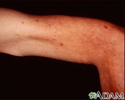Telangiectasia
Vascular ectasias; Spider veins
Telangiectasias are small, widened blood vessels on the skin. They are usually harmless, but may be associated with several diseases.
Causes
Telangiectasias may develop anywhere within the body. But they are most easily seen on the skin, mucous membranes, and whites of the eyes. Usually, they do not cause symptoms. Some telangiectasias bleed and cause significant problems. Telangiectasias may also occur in the brain and cause major problems from bleeding.
Causes may include:
- Rosacea
- Aging
- Genetics
- Pregnancy
- Sun exposure
- Varicose veins
Diseases associated with this condition include:
-
Ataxia - telangiectasia
Ataxia - telangiectasia
Ataxia-telangiectasia is a rare childhood disease. It affects the brain and other parts of the body. Ataxia refers to uncoordinated movements, such ...
 ImageRead Article Now Book Mark Article
ImageRead Article Now Book Mark Article - Bloom syndrome
- Cutis marmorata telangiectatica congenita
-
Hereditary hemorrhagic telangiectasia
(Osler-Weber-Rendu syndrome)
Hereditary hemorrhagic telangiectasia
Osler-Weber-Rendu syndrome is a disorder of the blood vessels that can cause excessive bleeding.
 ImageRead Article Now Book Mark Article
ImageRead Article Now Book Mark Article - Klippel-Trenaunay-Weber syndrome
-
Nevus flammeus
such as
port-wine stain
Nevus flammeus
Red birthmarks are skin markings created by blood vessels close to the skin surface. They develop before or shortly after birth.
 ImageRead Article Now Book Mark Article
ImageRead Article Now Book Mark ArticlePort-wine stain
A port-wine stain is a birthmark in which swollen blood vessels create a reddish-purplish discoloration of the skin.
 ImageRead Article Now Book Mark Article
ImageRead Article Now Book Mark Article - Rosacea
-
Spider angioma
Spider angioma
Spider angioma is an abnormal collection of blood vessels near the surface of the skin.
 ImageRead Article Now Book Mark Article
ImageRead Article Now Book Mark Article -
Sturge-Weber disease
Sturge-Weber disease
Sturge-Weber syndrome is a rare disorder that is present at birth. A child with this condition will have a port-wine stain birthmark (usually on the...
 ImageRead Article Now Book Mark Article
ImageRead Article Now Book Mark Article -
Xeroderma pigmentosa
Xeroderma pigmentosa
Xeroderma pigmentosum is a rare condition passed down through families in which the skin and tissue covering the eye are extremely sensitive to ultra...
 ImageRead Article Now Book Mark Article
ImageRead Article Now Book Mark Article
When to Contact a Medical Professional
Call your health care provider if you notice enlarged vessels in the skin, mucous membranes, or eyes.
What to Expect at Your Office Visit
The provider will perform a physical exam and ask about your symptoms, including:
- Where are the blood vessels located?
- Do they bleed easily and without reason?
- What other symptoms are present?
Tests may be needed to diagnose or rule out a medical condition. Tests may include:
- Blood tests
-
CT scans
CT scans
A computed tomography (CT) scan is an imaging method that uses x-rays to create pictures of cross-sections of the body. Related tests include:Abdomin...
 ImageRead Article Now Book Mark Article
ImageRead Article Now Book Mark Article - Liver function studies
-
MRI scans
MRI scans
A magnetic resonance imaging (MRI) scan is an imaging test that uses powerful magnets and radio waves to create pictures of the body. It does not us...
 ImageRead Article Now Book Mark Article
ImageRead Article Now Book Mark Article - X-rays
Sclerotherapy is the treatment for telangectasias on the legs. In this procedure, a saline (salt) solution or other chemical is injected directly into the spider veins on the legs. Laser treatment is typically used to treat telangiectasias of the face.
References
James WD, Berger TG, Elston DM. Cutaneous vascular diseases. In: James WD, Berger TG, Elston DM, eds. Andrews' Diseases of the Skin: Clinical Dermatology . 11th ed. Philadelphia, PA: Elsevier Saunders; 2011:chap 35.
Kelly R, Baker C. Other vascular disorders. In: Bolognia JL, Jorizzo JL, Schaffer JV, eds. Dermatology . 3rd ed. Philadelphia, PA: Elsevier Saunders; 2012:chap 106.
-
Angioma serpiginosum - illustration
Angioma serpiginosum appears most frequently in adolescent females and consists of small, superficial telangiectasias (vascular lesions) in the skin.
Angioma serpiginosum
illustration
-
Telangiectasia - legs - illustration
Essential telangiectasia often appears over the lower extremities, beginning in adolescence, and continuing throughout adult life.
Telangiectasia - legs
illustration
-
Telangiectasias - upper arm - illustration
Telangiectasias of the skin occur in multiple conditions. Thin skin secondary to long-term steroid use or aging, collagen vascular disease, and hormonal variation (particularly estrogen) are all implicated in the formation of telangiectasias.
Telangiectasias - upper arm
illustration
-
Angioma serpiginosum - illustration
Angioma serpiginosum appears most frequently in adolescent females and consists of small, superficial telangiectasias (vascular lesions) in the skin.
Angioma serpiginosum
illustration
-
Telangiectasia - legs - illustration
Essential telangiectasia often appears over the lower extremities, beginning in adolescence, and continuing throughout adult life.
Telangiectasia - legs
illustration
-
Telangiectasias - upper arm - illustration
Telangiectasias of the skin occur in multiple conditions. Thin skin secondary to long-term steroid use or aging, collagen vascular disease, and hormonal variation (particularly estrogen) are all implicated in the formation of telangiectasias.
Telangiectasias - upper arm
illustration
Review Date: 4/14/2015
Reviewed By: Kevin Berman, MD, PhD, Atlanta Center for Dermatologic Disease, Atlanta, GA. Review provided by VeriMed Healthcare Network. Also reviewed by David Zieve, MD, MHA, Isla Ogilvie, PhD, and the A.D.A.M. Editorial team.



